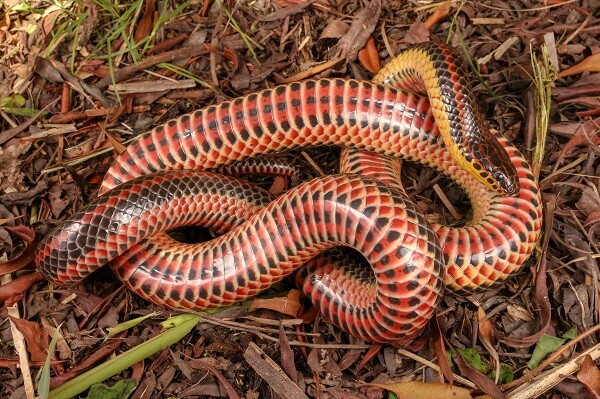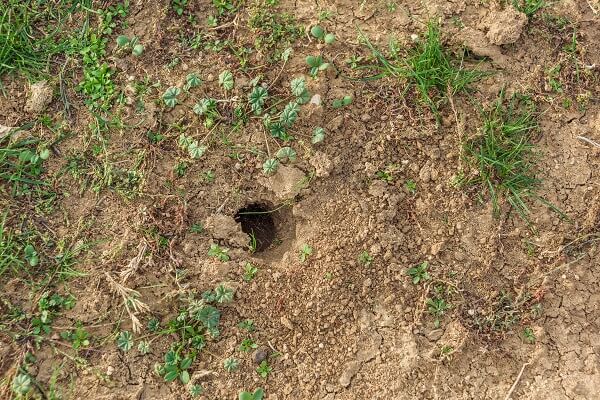
The rainbow snake (Farancia erytrogramma) – also known as the eel moccasin – is a large, non-venomous snake that is endemic to the United States of America. This colubrid snake is highly aquatic, spending most of its life hidden amongst aquatic vegetation and debris. It is so good at hiding that these snakes are rarely seen. This beautiful snake is mostly black, with three red stripes down its back. The belly is red or pink and has two or three rows of black spots on it. Its head and sides can sometimes have a yellowish color. The rainbow snake is found across the coastal plain of the southern United States, from southern Virginia to eastern Louisiana. It is usually found in cypress swamps and flowing water habitats such as creeks, streams, and rivers. These snakes can also inhabit tidal and brackish waters in coastal regions. Even though these snakes are mostly aquatic, it is not unusual to find them far from water. They make their nests on land, and some of the young may overwinter in the nest before emerging in the spring. Rainbow snakes breed once a year, usually in the late spring/early summer. The female will lay around 20 eggs in a burrow underground. The eggs incubate for 60 to 80 days, and the female stays with them for this time. After they begin to hatch, the female leaves and the juvenile snakes are on their own. Juvenile rainbow snakes eat an assortment of fish, frogs, worms, tadpoles, and salamanders. The adult’s diet mainly consists of American eels, which is how they got the nickname the eel moccasin. The snakes eat their prey alive, generally swallowing it headfirst. These snakes are mostly defenseless. They are not aggressive and will not bite if handled. They may send out a warning signal if disturbed. The snake will coil its body if it feels threatened, placing its head down while raising its tail in the air. The tail has spines on it that they usually use to control the prey they have caught, but they can also use to scare predators. The secretive nature of this snake means very little is known about its biology. However, from what we do know, this snake is an excellent example of several important biological concepts. Let’s take a closer look. As a mostly aquatic snake, it can be of little surprise that the rainbow snake is a great swimmer. Snakes move their body in lateral movements creating an S-like shape with their body. This movement propels them through the water. Rainbow snakes forage mostly underwater. They do not have gills like fish and must come to the surface to breathe. This means that to hunt underwater, they must hold their breath. Snakes that hunt in water can make use of a pause in breathing, also known as apnea. Apnea happens in nearly all animals between breaths. When we inhale, we draw air into our lungs. Before we exhale, we pause, although usually not for long. Unlike many animals – including humans – snakes can stay in this breathing pause for a long time. This is especially true if they are relaxed. Apnea is one mechanism that snakes can use to help them stay underwater for some time. It is not known precisely how long the rainbow snake can hold its breath. Once they have caught their prey, they will come to the surface and leave the water to eat it, enabling them to breathe again. Unlike other terrestrial species, female snakes are usually larger than the males, and the rainbow snake is no different. Females reach much larger sizes than males, averaging 66 in (167.6 cm) in length. Males average 42 in (107.4 cm) in length and have shorter bodies and longer tails than the females. The large size in a female snake compared to the male is considered an adaptive trait. Snakes, in general, have little or no parental care. A larger female can produce more and larger offspring, which increases the chances of survival. The males have to actively seek out and successfully court the females during the mating season. Their smaller size means that they are less visible to predators. It also means that they are more mobile and have lower energy costs for locomotion and tracking females. There are several different mating systems found in the animal kingdom. Rainbow snakes are polygynandrous. Polygynandry is a term used to describe the multi-male and multi-female polygamous mating system. In this mating system, a female will mate with several males, and those males will also mate with several females. There are several advantages to using this type of mating system. Unlike other species, the young rainbow snakes don’t need any parental care once they have hatched, so the males don’t need to stay around. This means that they can increase their reproductive success by mating with as many females as possible. The aim of this is to increase the number of offspring they have that survive to adulthood to pass on their genes. Similarly, for the female, mating with several males reduces the risk of unfertilized eggs. Other animals, such as chimpanzees and bonobos, rely on this mating system. However, with these animals, it ensures that they can live in cooperative groups and spend less time worrying about mate competition.
Kingdom
Animalia
Phylum
Chordata
Class
Reptilia
Order
Squamata
Family
Colubridae
Genus
Farancia
Species
F. erytrogramma
Length
Large – up to 66 in (168 cm)
Lifespan
Unknown
Social Structure
Solitary except during the mating season
Conservation Status
Least concern
Preferred Habitat
Aquatic, freshwater
Average clutch Size
20
Main Prey Species
American eels, fish, salamanders, tadpoles, worms, and small frogs
Predators
Raccoons, Virginia opossums, redtail hawks, eastern indigo snakes
The Basics

Interesting Insights from the Rainbow Snake!
Rainbow Snakes are Adapted for Aquatic Life

Sexual Dimorphism

Polygynandrous Mating System
